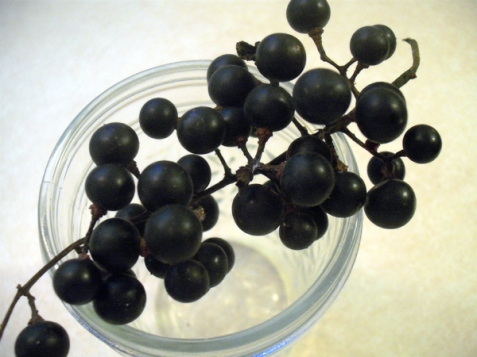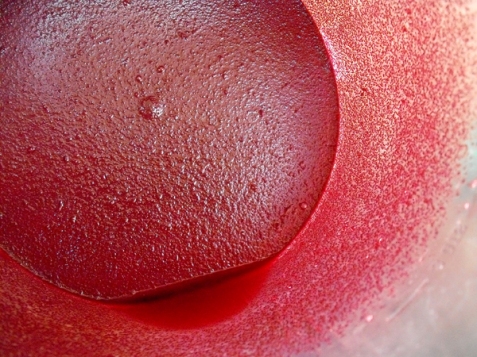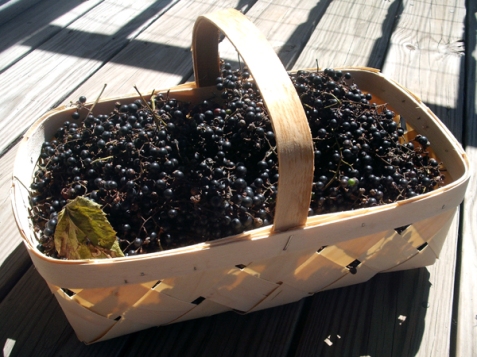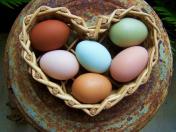I couldn’t get my hands on any Concord grapes this year. But it was a good year for the wild grapes and I came across a nice cluster of vines attached to a fallen tree which made them very easy to reach! I’ve always wanted to try making jelly from wild grapes and this was the year to do it. I ended up with a peck basket full.
They are small, but mighty! Wild grapes look a lot like your regular Concord grapes, but they are much smaller. Their seeds are still large and there is very little flesh to the fruit. All their flavor is contained in the skins. They have a deep, wine-like flavor.

Here is a cluster beside a few store-bought seedless red grapes for size comparison.

Once I got them all plucked, I was surprised how many grapes I actually had. They filled my 8 quart stockpot about 1/3 of the way full.
I prepared the juice as outlined in the Ball Blue Book, adding just enough distilled water to cover them by about half an inch. This was brought to a boil and simmered gently for an hour or so, until the fruit was well-cooked and soft.

I allowed that to cool enough to handle, then poured it into about 8 layers of cheesecloth. I like to tie the bag from the handle of a cabinet and let it drip overnight.
Now this is something the Ball Blue Book will not tell you and I learned from my mother-in-law. You must allow the juice to passively drip from the bag. Do not squeeze it! If you do, you will cause your juice to become cloudy. You can put the pulp back into the pot with a little more water and repeat the process to get some more juice out of it if you want.

Isn’t that a pretty color?

Now, yet another thing the Ball Blue Book will not tell you: for the clearest possible juice, you should let the pitcher of juice sit undisturbed in the refrigerator for 24 hours or so. This allows the tartaric acid crystals to settle out and they will form on the bottom and sides of your pitcher. Do not stir or disturb at all. When you gently pour out the juice, they will stay behind in the pitcher. Tartaric acid is very sour. This is the same compound from which cream of tartar is derived.

I made my jelly following the Ball Blue Book recipe. The first batch I did was with pectin. It made a gorgeous, burgundy colored jelly.
I had enough juice left over to do a half batch of grape jelly without pectin (also in the BBB.) It came out very nicely too. I think next time though, I will dilute the juice by one-fourth. The no-pectin recipe had a stronger, purer, wild grape flavor as a result of being boiled down.

The flavor of this jelly is so much more complex than that of regular grape jelly. I like that it has a little extra punch of tartness. It has a deeper flavor and I’ve thought hard about how to describe it. I would say it has a lambrusco grape/tart red cherry flavor.
I ended up with 5 pints and was very pleased with the results for my effort!








Rachael said,
October 17, 2013 at 12:57 PM
Thank you for posting this and your jelly color is lovely. I found and picked some wild grapes yesterday and juiced them up, strained twice (using first a larger meshed colander and then followed by a very fine meshed metal colander – no squeezing!). But then I forgot the step about letting it sit overnight to be able to leave the tartaric acid crystals behind and went on my merry way adding sugar and bringing the temp up. Then it hit me about the acid crystals (my MIL says hers always came out with crystals in her wild grape jelly and she didn’t know why). So, any idea on whether now, after sugar has been added and is dissolved (no crystals left), I can still put it in the frig to set overnight, pour off tomorrow and proceed? I realize you’re not a self-proclaimed expert, just wondering if you’ve ever made the mistake (or heard from another – you know how tales get told when canning, from other canners and their disasters and saves…) about if I can rescue it at this stage and back track a bit? I suppose I can either proceed and put up with crystals (it actually is not nearly as tart as I was anticipating) or make the experiment and see. Just hopeful of some advice. Thanks!
Journey11 said,
October 17, 2013 at 1:19 PM
Hi Rachael, thanks for your comment. I am not sure if they would settle out now or if the sugar would hold them in suspension, but it wouldn’t hurt to try. Even if they won’t, your jelly will still be good. It might just be a bit more opaque. Many people will skip this step. Really the worst thing you could do to make it cloudy is to squeeze the pulp instead of letting it passively drip. That would infuse much more of the tartaric acid into the juice.
L murano said,
November 8, 2010 at 10:16 AM
What lovely pictures and great instruction! Thank you for this. I’ve been considering making grapes from the vine we have. You make it look so easy….now I have to try it next season!
Paula Sayre said,
October 3, 2010 at 5:06 AM
Brings back memories! I did this when you kids were little……the flavor (and color) of wild grape jelly is just out of this world!
journey11 said,
October 3, 2010 at 12:55 PM
I remember being out somewhere with Dad picking some and bringing them home. 🙂
jojo said,
October 2, 2010 at 6:13 PM
What a gorgeous colour your jelly is! Worth all the time and work! I bet it tastes heavenly!
Cheryl Childers said,
October 2, 2010 at 4:53 PM
Boy Amanda you sure keep busy on Gods little Acre AKA One Sunny Acre. Great tips if I ever decide to make jelly from wild grapes. Love ya, Aunt Cheryl & Uncle Ray
journey11 said,
October 2, 2010 at 5:07 PM
I love that poem you wrote for us, it’s just right! 🙂